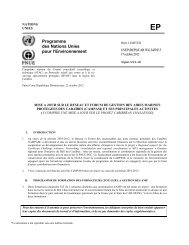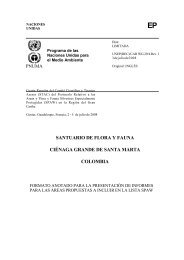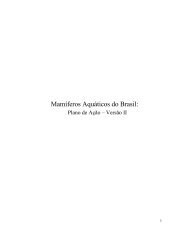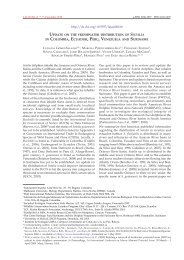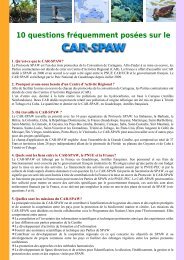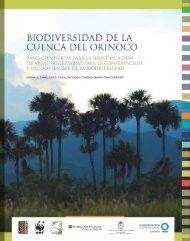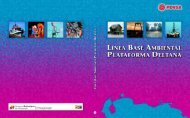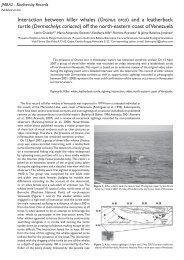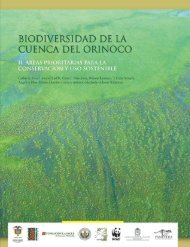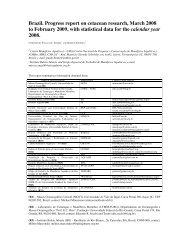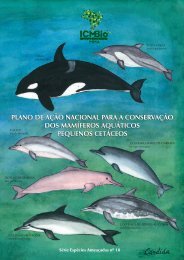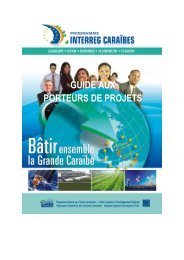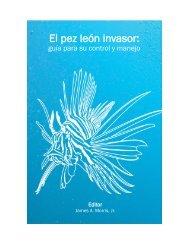46 PALACIOS <strong>et</strong> <strong>al</strong>.: CETACEAN DISTRIBUTION AND ABUNDANCE IN COLOMBIATable 1List of 23 c<strong>et</strong>acean species whose presence has been confirmed within Colombian Pacific waters.Common name Scientific name SourcePantropic<strong>al</strong> spotted dolphin Stenella attenuata Vid<strong>al</strong> (1990); Flórez-González <strong>and</strong> Capella (1995)Spinner dolphin Stenella longirostris Vid<strong>al</strong> (1990)Striped dolphin Stenella coeruleo<strong>al</strong>ba Vid<strong>al</strong> (1990)Rough-toothed dolphin Steno bredanensis Vid<strong>al</strong> (1990)Common dolphin Delphinus delphis Vid<strong>al</strong> (1990); Flórez-González <strong>and</strong> Capella (1995)Common bottlenose dolphin Tursiops truncatus Vid<strong>al</strong> (1990); Flórez-González <strong>and</strong> Capella (1995)Risso’s dolphin Grampus griseus Vid<strong>al</strong> (1990); Flórez-González <strong>and</strong> Capella (1995)Fraser’s dolphin Lagenodelphis hosei Vid<strong>al</strong> (1990)Melon-headed wh<strong>al</strong>e Peponoceph<strong>al</strong>a electra Vid<strong>al</strong> (1990)Pygmy killer wh<strong>al</strong>e Feresa attenuata Vid<strong>al</strong> (1990)F<strong>al</strong>se killer wh<strong>al</strong>e Pseudorca crassidens Vid<strong>al</strong> (1990); Flórez-González <strong>and</strong> Capella (1995)Short-finned pilot wh<strong>al</strong>e Globiceph<strong>al</strong>a macrorhynchus Vid<strong>al</strong> (1990); Flórez-González <strong>and</strong> Capella (1995)Killer wh<strong>al</strong>e Orcinus orca Vid<strong>al</strong> (1990); Flórez-González <strong>and</strong> Capella (1995)Sperm wh<strong>al</strong>e Phys<strong>et</strong>er macroceph<strong>al</strong>us Vid<strong>al</strong> (1990); Flórez-González <strong>and</strong> Capella (1995)Dwarf sperm wh<strong>al</strong>e Kogia sima Vid<strong>al</strong> (1990); Flórez-González <strong>and</strong> Capella (1995)Blainville’s beaked wh<strong>al</strong>e Mesoplodon densirostris Flórez-González <strong>and</strong> Capella (1995)Cuvier’s beaked wh<strong>al</strong>e Ziphius cavirostris Vid<strong>al</strong> (1990); Flórez-González <strong>and</strong> Capella (1995)Minke wh<strong>al</strong>e B<strong>al</strong>aenoptera acutorostrata Vid<strong>al</strong> (1990)Bryde’s wh<strong>al</strong>e B<strong>al</strong>aenoptera edeni Vid<strong>al</strong> (1990); Flórez-González <strong>and</strong> Capella (1995)Sei wh<strong>al</strong>e B<strong>al</strong>aenoptera bore<strong>al</strong>is Vid<strong>al</strong> (1990)Humpback wh<strong>al</strong>e Megaptera novaeangliae Vid<strong>al</strong> (1990); Flórez-González <strong>and</strong> Capella (1995)Fin wh<strong>al</strong>e B<strong>al</strong>aenoptera phys<strong>al</strong>us Vid<strong>al</strong> (1990)Blue wh<strong>al</strong>e B<strong>al</strong>aenoptera musculus Mora-Pinto <strong>et</strong> <strong>al</strong>. (1995); Van Waerebeek <strong>et</strong> <strong>al</strong>. (1997)1). At least 23 c<strong>et</strong>acean species are known to occur in thesewaters (Flórez-González <strong>and</strong> Capella, 1995; Flórez-González <strong>et</strong> <strong>al</strong>., 2004a; Vid<strong>al</strong>, 1990) (Table 1). Extensivebiologic<strong>al</strong> information <strong>and</strong> a comprehensive conservationstrategy exist for the humpback wh<strong>al</strong>e (Megapteranovaeanglieae) as a product of more than 20 years of study(Flórez-González <strong>et</strong> <strong>al</strong>., 2007). Efforts <strong>al</strong>so have beenundertaken to document the c<strong>et</strong>acean fauna inhabiting thewaters around the isl<strong>and</strong>s of Gorgona (Flórez-González <strong>and</strong>Capella, 2001; Flórez-González <strong>et</strong> <strong>al</strong>., 2004b) <strong>and</strong> M<strong>al</strong>pelo(Herrera <strong>et</strong> <strong>al</strong>., 2007). However, much less is known aboutthe occurrence of c<strong>et</strong>aceans outside these locations, inparticular for those species occurring in offshore waters.Abundance estimates for selected species have beenpresented by Gerrod<strong>et</strong>te <strong>and</strong> <strong>P<strong>al</strong>acios</strong> (1996) based onregion<strong>al</strong>-sc<strong>al</strong>e line-transect surveys for the period 1986–1993(Table 2), but no more recent estimates are available <strong>and</strong> nocomprehensive maps of c<strong>et</strong>acean <strong>distribution</strong> have ever beenpublished for Colombia’s EEZ. This paper presents, for thefirst time, <strong>distribution</strong><strong>al</strong> maps for 19 species <strong>and</strong> one genusoccurring in Colombian waters, based on a compilation ofsightings collected aboard survey cruises <strong>and</strong> platforms ofopportunity b<strong>et</strong>ween 1986 <strong>and</strong> 2008. It <strong>al</strong>so provides, withsome important caveats, group encounter rates <strong>and</strong> typic<strong>al</strong>group sizes to give a more compl<strong>et</strong>e picture of the occurrencepatterns of these species. Fin<strong>al</strong>ly, the paper discusses whathas been learned from these efforts <strong>and</strong> identifies gaps inknowledge <strong>and</strong> research needs.DATA SOURCESSince the purpose was to obtain as compl<strong>et</strong>e a picture aspossible of the patterns of c<strong>et</strong>acean occurrence in Colombia’sPacific EEZ, sightings data were compiled from dedicatedc<strong>et</strong>acean surveys as well as from platforms of opportunityoperating in these waters b<strong>et</strong>ween 1986 <strong>and</strong> 2008. D<strong>et</strong>ails ofthese programmes are as follows.SWFSC line-transect cruisesThe Southwest Fisheries Science Center (SWFSC), part ofthe Nation<strong>al</strong> Marine Fisheries Service (NMFS) of the U.S.Nation<strong>al</strong> Oceanic <strong>and</strong> Atmospheric Administration (NOAA),has conducted systematic line-transect surveys for c<strong>et</strong>aceansthroughout the eastern tropic<strong>al</strong> Pacific (in internation<strong>al</strong> watersas well in the EEZs of sever<strong>al</strong> Centr<strong>al</strong> <strong>and</strong> South AmericanTable 2Estimates of c<strong>et</strong>acean abundance (N, in number of anim<strong>al</strong>s) <strong>and</strong> density (D, in number of anim<strong>al</strong>s per 1,000km 2 ) forColombia’s Pacific EEZ, with lower (N low) <strong>and</strong> upper (N up) limits of the 95% confidence interv<strong>al</strong>s, based on SWFSC lin<strong>et</strong>ransectsurveys conducted b<strong>et</strong>ween 1986 <strong>and</strong> 1993 (source: Gerrod<strong>et</strong>te <strong>and</strong> <strong>P<strong>al</strong>acios</strong>, 1996).Common name Scientific name N N lowN upDPantropic<strong>al</strong> spotted dolphin Stenella attenuata 3,934 1,755 8,820 11.9Striped dolphin Stenella coeruleo<strong>al</strong>ba 25,785 17,324 38,379 78.3Rough-toothed dolphin Steno bredanensis 4,366 1,869 10,200 13.3Common dolphin Delphinus delphis 12,369 4,136 36,989 37.5Common bottlenose dolphin Tursiops truncatus 7,171 3,548 14,493 21.8Risso’s dolphin Grampus griseus 7,266 3,599 14,668 22.1Short-finned pilot wh<strong>al</strong>e Globiceph<strong>al</strong>a macrorhynchus 1,140 450 2,892 3.5Beaked wh<strong>al</strong>es Ziphius cavirostris <strong>and</strong> Mesoplodon spp. 30,784 10,633 89,119 93.4Sperm wh<strong>al</strong>e Phys<strong>et</strong>er macroceph<strong>al</strong>us 1,248 643 2,422 3.8Bryde’s wh<strong>al</strong>e B<strong>al</strong>aenoptera edeni 109 37 321 0.3
J. CETACEAN RES. MANAGE. 12(1): 45–60, 2012 47Fig. 1. Left: Colombia’s exclusive economic zone (EEZ) in the Pacific Ocean (source: DIMAR, 1988). Loc<strong>al</strong>ities mentioned in the text are labelled. Bathym<strong>et</strong>riccontours correspond to the 100, 200, 500, 1,000 <strong>and</strong> 2,000m isobaths (source: SRTM30_PLUS glob<strong>al</strong> topography v.6.0, available from http://topex.ucsd.edu/).Right: Politic<strong>al</strong> boundaries of Colombia <strong>and</strong> its location in the Southeast Pacific.countries) every few years b<strong>et</strong>ween 1986 <strong>and</strong> 2006 (1986–1990, 1992, 1998–2000, 2003 <strong>and</strong> 2006). The purpose ofthese surveys is to estimate population size <strong>and</strong> to monitortrends in the abundance of sever<strong>al</strong> dolphin stocks that havebeen affected by incident<strong>al</strong> mort<strong>al</strong>ity in the internation<strong>al</strong>purse-seine fishery for tuna (Gerrod<strong>et</strong>te, 2002). Them<strong>et</strong>hodology has been documented in d<strong>et</strong>ail elsewhere (e.g.Gerrod<strong>et</strong>te <strong>and</strong> Forcada, 2005; Kinzey <strong>et</strong> <strong>al</strong>., 2000; Wade <strong>and</strong>Gerrod<strong>et</strong>te, 1993), but briefly, the ship-based surveys takeplace from late July to early December following pred<strong>et</strong>erminedr<strong>and</strong>om tracklines at a nomin<strong>al</strong> cruising speed of10 knots (18.5km/h). A team of three observers conduct visu<strong>al</strong>searching for c<strong>et</strong>aceans during daylight hours (dawn to dusk)from the ship’s flying bridge using 25x150mm pedest<strong>al</strong>mountedbinoculars in sea state conditions ranging from 0 to6 in the Beaufort sc<strong>al</strong>e. Angle <strong>and</strong> radi<strong>al</strong> distance to eachsighting are recorded upon initi<strong>al</strong> sighting, <strong>and</strong> the ship is thendiverted to approach the anim<strong>al</strong>s in order to obtain speciesidentity <strong>and</strong> group size. B<strong>et</strong>ween 1986 <strong>and</strong> 2000, two 52mresearch vessels, the McArthur <strong>and</strong> the David Starr Jordan,were used, both having an observation height of 11m abov<strong>et</strong>he water line. An addition<strong>al</strong> ship, the 57m R/V Endeavor,with an observation height of 10m, was used during the 1998survey. Starting with the 2003 survey, the McArthur wasreplaced with the 68m McArthur II, with an observationheight of 15m.The Siben <strong>and</strong> Odyssey expeditionsTwo expeditions to study c<strong>et</strong>aceans in South Americanwaters were conducted under the joint auspices of the OceanAlliance (under the former names of Long-term ResearchInstitute <strong>and</strong> Wh<strong>al</strong>e Conservation Institute) <strong>and</strong> the InterpolarResearch Soci<strong>et</strong>y. The purpose of these expeditions was tostudy the biology of the sperm wh<strong>al</strong>e (Phys<strong>et</strong>ermacroceph<strong>al</strong>us) <strong>and</strong> the humpback wh<strong>al</strong>e while providingtraining in c<strong>et</strong>acean research techniques to loc<strong>al</strong> scientists(see <strong>al</strong>so Pardo <strong>et</strong> <strong>al</strong>., 2009). The first expedition operated inColombian waters aboard the R/V Siben, a 25.9m sailboat,b<strong>et</strong>ween May <strong>and</strong> July 1998 (Torres <strong>et</strong> <strong>al</strong>., 1988), while thesecond one took place at various times during 1993(February, September, October) <strong>and</strong> 1994 (April) aboard theR/V Odyssey, a 28.4m sailboat (Ocean Alliance, unpublisheddata). On both ships, two observers maintained visu<strong>al</strong>watches during daylight hours (07:00–18:00h, weatherpermitting), using the naked eye or h<strong>and</strong>-held binoculars. Onthe Siben, the observation was conducted from the bow <strong>and</strong>the stern (3–4m above the waterline), while on the Odysseyobservers were positioned atop the ship’s pilothouse (4mabove the waterline) <strong>and</strong> in the crow’s nest on the main mast(18m above the waterline). Sightings of other c<strong>et</strong>aceanspecies were recorded while searching for the targ<strong>et</strong> speciesbut the associated search effort data were not available.DIMAR oceanographic cruisesThe Dirección Gener<strong>al</strong> Marítima de Colombia (DIMAR),through its Centro de Control de Contaminación del Pacífico(CCCP), conducts long-term studies of the El Niñophenomenon in Colombia’s Pacific EEZ with a series ofbiannu<strong>al</strong> oceanographic cruises known as ‘Pacífico’ (norm<strong>al</strong>lyin February or March) <strong>and</strong> ‘ERFEN’ (in September). Eachcruise uses one of two ships, either R/V Providencia or R/VM<strong>al</strong>pelo, both 50.9m long, <strong>and</strong> takes about 20 effective seadays to compl<strong>et</strong>e. Two nation<strong>al</strong> non-profit organisations,Fundación Yubarta <strong>and</strong> Fundación M<strong>al</strong>pelo, have placedmarine mamm<strong>al</strong> observers on seven of these cruises b<strong>et</strong>ween2004 <strong>and</strong> 2008. Observation effort takes place during travel



